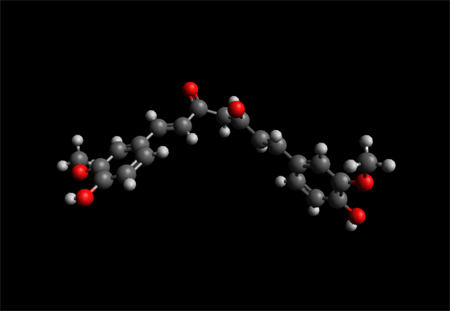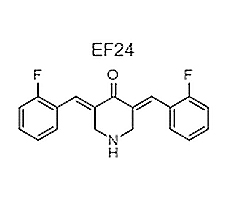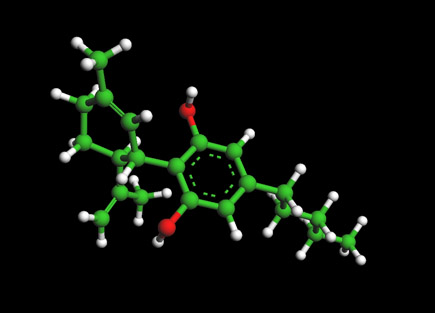Curcumin and Curcumin Analogs--Anti-Aging and Senolytic Properties

Ball and Stick Model for Curcumin Molecule
Curcumin Molecule (above) Ball-and-stick. For 3D Jsmol File
Chemical formula--C21H20O6
Molar Mass --- 368.385 g·mol−1
About Curcumin
Curcumin is a bright yellow chemical produced by Curcuma longa plants. It is the principal curcuminoid of turmeric (Curcuma longa), a member of the ginger family, Zingiberaceae. Chemically, curcumin is a diarylheptanoid, belonging to the group of curcuminoids, which are natural phenols responsible for turmeric's yellow color.
The use of turmeric in Asia dates back more than 2000 years where it was used in cooking, medicine, cosmetics and fabric dyes.
Curcumin is a tautomeric compound existing in enolic form in organic solvents and in keto form in water.
Curcumin Molecular Structure (Keto form)

Curcumin Molecular Structure (Enol Form)
The enol form is more energetically stable in the solid phase and, depending on the solvent, up to 95% can be in the enol form

Overview of Curcumin in Aging and Senescence
There are plenty of examples to support the possible anti-ageing role of curcumin [72,73,74,75]. Curcumin supplementation in a diet extended the lifespan of fruit flies, nematodes and mice [76,77,78,79]. Moreover, in clinical trials, curcumin was proven to reduce symptoms of some age-related diseases such as atherosclerosis, diabetes and cancer [80,81]. It also serves as a neuroprotective agent [82]. see: The Role of Curcumin in the Modulation of Ageing and references therein.
curcumin is involved in the regulation of nutrient-sensing signaling pathways (impact on sirtuins, AMPK), and thus it is able to mimic caloric/diet restriction and increase the benefits coming from mild physical activity. Another important but not always direct anti-ageing function of curcumin is its anti-tumor activity
Bioavailability of Curcumin and search for Analogs
Curcumin is poorly absorbed by intestinal cells (low aqueous solubility and stability), rapidly metabolized by the liver (generation of less active curcumin glucuronides, see paragraph), and rapidly eliminated from an organism.
Abstracts:
11 July 2013 Curcumin and its Derivatives: Their Application in Neuropharmacology and Neuroscience in the 21st Century
Curcumin (diferuloylmethane), a polyphenol extracted from the plant Curcuma longa, is widely used in Southeast Asia, China and India in food preparation and for medicinal purposes. Since the second half of the last century, this traditional medicine has attracted the attention of scientists from multiple disciplines to elucidate its pharmacological properties. Of significant interest is curcumin’s role to treat neurodegenerative diseases including Alzheimer’s disease (AD), and Parkinson’s disease (PD) and malignancy. These diseases all share an inflammatory basis, involving increased cellular reactive oxygen species (ROS) accumulation and oxidative damage to lipids, nucleic acids and proteins. The therapeutic benefits of curcumin for these neurodegenerative diseases appear multifactorial via regulation of transcription factors, cytokines and enzymes associated with (Nuclear factor kappa beta) NFκB activity. This review describes the historical use of curcumin in medicine, its chemistry, stability and biological activities, including curcumin's anti-cancer, anti-microbial, anti-oxidant, and anti-inflammatory properties. The review further discusses the pharmacology of curcumin and provides new perspectives on its therapeutic potential and limitations. Especially, the review focuses in detail on the effectiveness of curcumin and its mechanism of actions in treating neurodegenerative diseases such as Alzheimer’s and Parkinson’s diseases and brain malignancies. see full publication.
12 March 2019 The Role of Curcumin in the Modulation of Ageing
"...It is believed that postponing ageing is more effective and less expensive than the treatment of particular age-related diseases. Compounds which could delay symptoms of ageing, especially natural products present in a daily diet, are intensively studied. One of them is curcumin. It causes the elongation of the lifespan of model organisms, alleviates ageing symptoms and postpones the progression of age-related diseases in which cellular senescence is directly involved. It has been demonstrated that the elimination of senescent cells significantly improves the quality of life of mice. There is a continuous search for compounds, named senolytic drugs, that selectively eliminate senescent cells from organisms. In this paper, we endeavor to review the current knowledge about the anti-ageing role of curcumin and discuss its senolytic potential.... Our own data shown that curcumin anti-ageing function results neither from its anti-senescent nor senolytic function, even though curcumin is able to modulate cellular senescence. Low doses activated sirtuins and AMPK, which are considered as having anti-senescent properties, but cytostatic doses inhibited sirtuins and AMPK, inducing, in this manner, cellular senescence..." see full publication
2017 Aug 30 Nanocurcumin is superior to native curcumin in preventing degenerative changes in Experimental Cerebral Malaria
Curcumin has many pharmacological activities despite its poor bioavailability and in vivo stability. Here, we show that a nanoformulated curcumin (PLGA-curcumin) has better therapeutic index than native curcumin in preventing the onset of neurological symptoms and delaying the death of mice in experimental cerebral malaria. Oral PLGA-curcumin was at least as effective as native curcumin at a 15-fold lower concentration in preventing the breakdown of blood-brain barrier and inhibition of brain mRNAs for inflammatory cytokines, chemokine receptor CXCR3 and its ligand CXCL10, with an increase in the anti-inflammatory cytokine IL-10. This was also reflected in serum cytokine and chemokine levels. At equivalent concentrations, a single oral dose of PLGA-curcumin was more effective in inhibiting serum IFNγ levels and enhancing IL-10 levels than native curcumin. Even at low concentrations, PLGA-curcumin was superior to native curcumin in inhibiting the sequestration of parasitized-RBCs and CD8+ T cells in the brain. A single oral dose of 5 mg PLGA-curcumin containing 350 μg of curcumin resulted in 3–4 fold higher concentration and prolonged presence of curcumin in the brain than that obtained with 5 mg of native curcumin, indicating better bioavailability of PLGA-curcumin. PLGA-curcumin has potential as an adjunct drug to treat human cerebral malaria see full publication
21 February 2019 Antioxidant activity of curcuminoids
An exploration of the antioxidant power of curcumin, demethoxycurcumin, and bisdemethoxycurcumin, three natural antioxidants found in Curcuma longa, is reported in this work. We exhaust all structural possibilities leading to intramolecular hydrogen bonding and evaluate 15 isomers in total. Calculations were carried out in the gas phase and in the presence of solvents (water, to mimic biological media, and ethanol, to reproduce experimental assays) following the hydrogen atom transfer (HAT) and single electron transfer (SET) mechanisms. CH3O⋯H–O hydrogen bonds are directly related to the antioxidant power via both mechanisms. We provide evidence to explain the experimental observations and to understand the fundamental factors driving antioxidant activity from a molecular perspective. Noticeably, the solvent enhances the antioxidant power in every case. All structures considered here are predicted to have better antioxidant abilities than phenol, and come very close to or surpass vitamin E. see article
11 March 2016 --Determining whether curcumin degradation/condensation is actually bioactivation (Review)
Curcumin has been shown to exert therapeutic or protective effects against a variety of diseases, such as cancer, pulmonary diseases, neurological, liver, metabolic, autoimmune, cardiovascular diseases and numerous other chronic ailments. Over 116 clinical studies on curcumin in humans were registered with the US National Institutes of Health in 2015. However, it is mystifying how curcumin can be so effective in the treatment of many diseases since it has very low water solubility and bioavailability. Furthermore, curcumin is not stable under various conditions; its degradation or condensation into different bioactive compounds may be responsible for its biological activities rather than curcumin itself. In this review, we provide evidence of curcumin degradation and condensation into different compounds which have or may have health benefits themselves. Literature reviews strongly suggest that these molecules contribute to the observed health benefits, rather than curcumin itself. see full article
14 Aug 2019 Curcumin analogues and derivatives with anti-proliferative and anti-inflammatory activity: Structural characteristics and molecular targets.
Curcumin (Diferuloylmethane) is a natural phenolic compound, which belongs to the curcuminoid family, presenting pleiotropic activity and low bioavailability. A lot of recent research is focused on the design and synthesis of curcumin analogs as antiproliferative and anti-inflammatory agents improving the bioavailability and target selectivity. Their structural characteristics and functional groups seem to define the extent of the biological activity. Areas covered: Publications (2008-2018), describing curcumin analogs and curcumin derivatives are analyzed. Structural characteristics, functional groups, modelling studies, structure activity relationships, biological evaluation in vitro/in vivo as antiproliferative and anti-inflammatory agents are included. Furthermore, a wide range of biological results derived from different targets are also summarized. Expert opinion: Several curcumin analogs and derivatives appear to have a high biological impact as well as promising antiproliferative and anti-inflammatory activities. Their clinical evaluation will be critical to assess therapeutic utility. Compounds for which the mechanism of action is well defined can serve as lead compounds for the design of new more potent molecules. see article1 Apr 2019 Design and synthesis novel di-carbonyl analogs of curcumin (DACs) act as potent anti-inflammatory agents against LPS-induced acute lung injury (ALI).
A novel series of di-carbonyl analogs of curcumin (DACs) were prepared and evaluated for their anti-inflammatory properties. Preliminary results showed that a vast majority of compounds tested in this study could effectively suppress LPS-induced production of tumor necrosis factor (TNF)-α and interleukin (IL)-6. Structure-activity relationships of the compounds were discussed. Compounds 5a27 and 5a28 showed the most potent anti-inflammatory activities and had higher structural stability and orally bioavailability than curcumin in vitro. Mechanistically, they inhibited the activation of macrophages via the blockade of mitogen-activated protein kinase (MAPK) signaling and nuclear translocation of NF-κB. In vivo, 5a27 and 5a28 markedly alleviated lipopolysaccharides (LPS)-induced acute lung injury (ALI). The wet/dry ratio of lungs was significantly normalized by the active compounds, which was consistent with the suppression of neutrophil infiltration and production of proinflammatory cytokines. Collectively, these results present a new series of curcumin analogs as promising anti-inflammatory agents for treatment of ALI. see article
28 January 2019 --The curcumin analog EF24 is a novel senolytic agent
Cellular senescence is a hallmark of aging because senescent cells (SCs) accumulate with aging and play a causative role in age-related diseases. Selectively eliminating SCs has been emerging as a new strategy for treating age-related diseases and extending healthspan. Curcumin and its analogs have some anti-aging activities. However, the mechanisms of their action have not been fully elucidated. In the present study, we investigated whether various curcumin analogs can function as a senolytic agent. The results from our studies show that among these curcumin analogs EF24

EF24 CURCUMIN ANALOG
is the most potent and broad-spectrum senolytic agent. Mechanistically, EF24 selectively kills SCs by inducing SC apoptosis in a reactive oxygen species (ROS) production independent manner but associated with an increase in the proteasome degradation of the Bcl-2 anti-apoptotic protein family proteins known to play an important role in protecting SCs from apoptosis. In addition, EF24 can synergistically kill SCs with ABT-263, a Bcl-2 and Bcl-xl inhibitor and a known senolytic agent. These findings provide new insights into the mechanisms by which curcumin analogs function as an anti-aging agent and suggest that the curcumin analog EF24 has the potential to be used as a novel senolytic agent for the treatment of age-related diseases. see full publication
Anti-Aging and Senolytics Home Page
- What is Anti-Aging Medicine
- What is Senescence?
- What are Senolytics?
- About Caloric Restriction
- Mtor and Rapamycin
- The IKK/NF-κB signaling pathway in aging
- Exercise and Anti-Aging
- Meditation and Anti-Aging
SENOLYTIC AND ANTI-AGING MOLECULES
RAPAMYCIN ---The mechanistic target of rapamycin (mTOR) pathway has a central role in cell activation...
METFORMIN -- The diabetes drug metformin used by some for anti-aging may diminish benefits of aerobic exercise...
QUERCETIN-- AND WITH DASATINIB--The senolytic cocktail, dasatinib plus quercetin, which causes selective elimination of senescent cells...
FISETIN--Of the 10 flavonoids tested, fisetin was the most potent senolytic...
EGCG- The most active component of green tea....
NAD BOOSTERS --'...The cells of the old mice were indistinguishable from the young mice, after just one week of treatment...
SULFORAPHANE-- An isothiocyanate present in cruciferous vegetables activates antioxidant and anti-inflammatory responses by ...
UROLITHIN --Metabolite of Pomegranate compound with anti-aging effects passes human trial...
MITO-Q -- A water soluble fomr of CoQ10 that has excellent absorption and high bioavailability...
HONOKIOL - A bioactive natural product derived from Magnolia Bark have demonstrated ...
CURCUMIN AND ANALOGS -Recent research is focused on the design and synthesis of curcumin analogs as antiproliferative and anti-inflammatory agents...
BERBERINE --berberine has recently been reported to expand life span in Drosophila melanogaster, and attenuate premature cellular senescence
N-ACETYL-CYSTINE (NAC)--"...pretreatment with NAC increased glutathione levels in the older cells and largely helped offset that level of cell death..."
PIPERLONGUMINE - A natural product from the Long pepper with high bioavailability...
RESVERATROL AND PTEROTSILBINE -- Pterostilben chemically similar to resveratrol bute differs from resveratrol by exhibiting increased bioavailability (80% compared to 20% in resveratrol)
SPERMIDINE--Spermidine delays aging in humans ...
ALLICIN -- Allicin is a compound produced when garlic is crushed or chopped. ...
VITAMIN D3 -- Production of the active forms of Vitamin D are reduced by 50% as a result of an age-related decline
VITAMIN K-- evidence suggests vitamin K has an anti-inflammatory action
TOCOTRIENOL(AND WITH QUERCETIN) --Tocotrieniols have been found to exert a synergistic antitumor effect on cancer cells when given in combination....
HSP-90 INHIBITORS --As a novel class of senolytics
The Cannabidiol Molecule
Cannabidiol (CBD is the major non-psychoactive component of Cannabis and is being looked at by major drug and consumer companies for various medical and social uses.